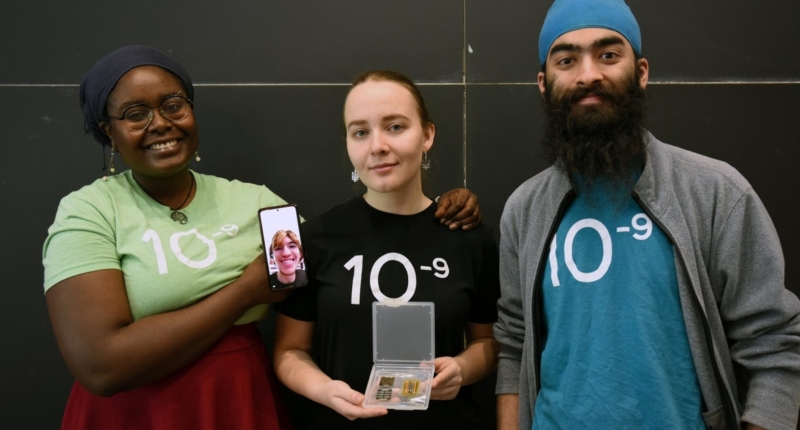MIT’s class 6.2540 provides students with hands-on experience using tools for nanoscale engineering inside MIT.nano’s cleanroom and other labs. The course takes a design approach, which closely integrates weekly lab modules and design projects. Students learn fundamental skills to design and build spectrometers, quantum dots, light-emitting diodes (LEDs), tunneling chemical sensors, and other nanoscale technologies. The course’s popularity has grown because of the opportunity to work with state-of-the-art equipment and experienced instructors, making it a quintessential MIT experience.
Each week’s lab work builds off the previous one, starting at the nano- and micro-level and building up to full-scale devices. For their end-of-semester projects, students split into teams to design and build something entirely from scratch, provided their idea uses the science, materials, and techniques covered in the class and has at least one feature smaller than 100 nanometers.
In the fall 2022 semester, the undergraduates fabricated memristors for next-generation unconventional computing, nature-inspired structured lenses to improve LED efficiency, flexible graphene supercapacitors for solar energy storage, a flexible pulse oximeter, tandem solar cells based on band-gap engineering, and a transistor using atomically-thin 2D materials.
In addition to the opportunity to work in MIT.nano’s cleanroom and other labs, students can present their projects at the Microsystems Annual Research Conference (MARC), co-sponsored by the Microsystems Technology Laboratories and MIT.nano.
MIT undergraduates have the unique opportunity to delve into the world of nanotechnology through a hands-on approach in class 6.2540 (Nanotechnology: From Atoms to Systems), taught by three EECS professors. The nine-week course is held inside MIT.nano’s labs, where students learn fundamental skills that allow them to design and build spectrometers, quantum dots, light-emitting diodes (LEDs), tunneling chemical sensors, and other nanoscale technologies.
The class is gaining popularity among undergraduates from various academic backgrounds, with six academic departments represented among the 23 students enrolled in fall 2022. Many students are drawn to the class for the opportunity to work with state-of-the-art equipment and experienced instructors.
The class takes a design approach, which is closely integrated with weekly lab modules and design projects. Starting in the first week, students work in a cleanroom and learn the basic skills needed to investigate and implement concepts learned in lectures. The professors teach the fundamentals of quantum mechanics and nanoscale science through the design and engineering of diverse technologies.
The hands-on approach to learning nanoscale science and engineering has generated excitement among students. Senior physics major Dahlia Dry said the class was exactly what she thought MIT would be like, while EECS junior Neil Deshmukh described the course as one of the best experiences he has had at MIT.
In summary, the class provides undergraduates with the skills and knowledge needed to design and build nanoscale technologies. The class’s popularity is growing, and it is taught by experienced professors who take a design approach to teaching. The hands-on learning approach has generated excitement among students, making the class a quintessential MIT experience.
MIT’s class 6.2540, Nanotechnology: From Atoms to Systems, offers students hands-on experience with nanoscale engineering through a design approach. Undergraduates learn fundamental skills to design and build spectrometers, quantum dots, light-emitting diodes (LEDs), tunneling chemical sensors, and other nanoscale technologies in MIT.nano’s labs. The course’s popularity has grown because of the opportunity to work with state-of-the-art equipment and experienced instructors, and students from six academic departments were represented among the 23 students enrolled in fall 2022.
Rather than watching staff run the equipment, students do the work themselves using simplified engineering and fabrication flows. Each week’s lab work builds off the ones before, starting at the nano- and micro-level and building up to full-scale devices. Students learn about light-matter interactions and build their own microscopes and spectrometers, then use their new tools to characterize the materials and devices they make throughout the term.
For their end-of-semester projects, the students split into teams to design and build something entirely from scratch, provided their idea uses the science, materials, and techniques covered in the class and has at least one feature smaller than 100 nanometers. In the fall 2022 semester, undergraduates fabricated memristors for next-generation unconventional computing, nature-inspired structured lenses to improve LED efficiency, flexible graphene supercapacitors for solar energy storage, a flexible pulse oximeter, tandem solar cells based on band-gap engineering, and a transistor using atomically-thin 2D materials.
In addition to the opportunity to work in MIT.nano’s cleanroom and other labs, students can present their projects at the Microsystems Annual Research Conference (MARC), co-sponsored by the Microsystems Technology Laboratories and MIT.nano. This long-standing event traditionally features graduate-level research and brings together over 200 MIT faculty, students, and industry partners each year.
The course provides students with the skills and knowledge necessary to design and build nanoscale technologies. Through a design approach, students acquire fundamental skills and have the opportunity to work with state-of-the-art equipment, making this course a quintessential MIT experience.
Don’t miss interesting posts on Famousbio









